Credit Card , Domain Name, Spoofing and Phishing
Updated: Aug 22 to add that the Postbank now informs their users about the use of the arcot domain.
Updated: Aug 24, some slights textual edits.
Updated April 8, 2012: html code and moved pictures to a different location
Often people argue that DNS spoofing will not impact peoples ability to do banking and such. With the current practices both with user interfaces as well as the practices that the banks themselves deploy I claim that this is close to nonsense.
The basic attack is that user Alice wants to connect to her website: www.postbank.nl, in order to do a secure transaction the bank will redirect her to a secure website. If Alice is smart she will check the security of the connection by looking at the padlock and verifying if the domain she connects to make sense.
This is not going to work as long as:
- browsers do not display the domain and only a padlock, so users need to actually dig deep before they are aware of possible problems
- and banks happily redirect to domains hosted by unknown 3rd parties so that users are used to providing information to seemingly unrelated parties.
The obvious DNS based attack is to redirect the unsecured postbank.nl site and provide link to postbank.malice.nl that have valid certificates. We all know that getting a certificate for postbank.malice.nl is a trivial matter, it takes an e-mail address and a credit card number.
Below is an example that banks take it for granted that users trust Arcot.com as a middle man for either Mastercard or the Postbank. And personally I have never heard of arcot.com, so what do I know.
The point I am making is that as long as Banks and Creditcard companies are implementing practices that make users get used to being redirected to completely unrelated, albeit HTTPS secured domains, they will not help to create a mindset where users will understand when they are subject to certain kinds of fraud, like phishing.
My experience today
Apparently there is some new mechanism introduced to secure Internet credit card payments. Its called MasterCard SecureCode. I did not know about this, but that may be because I have not seen the snail mail yet. I was introduced to this new protection mechanism to protect against fraud while trying to pay for a conference.
The original website redirected me to a site from tripledeal.com for the payment transaction. Even though the original website did not tell me that the transaction was to be handled by triple deal I decided to take the leap of confidence based on prior experience.
So far so good.
At the end of the payment process a new validation step is introduced: I am invited to go to my bank to validate the payment.
So pressing the “To Your Bank” button opens up a new window.
Oh… wait.
This screen asks me about details about my credit card. I need to be extra suspicious about entering information. Let me click on the padlock to verify that I am actually talking to my bank.
Oh.. so an organization called arcot.com is claiming to represent my bank? I do not believe that, anybody could be claiming to be my bank, even with that little padlock in place.
So, there is this new validation scheme I have never heard of, that needs some of my credentials, and that takes me to a site that does not seem to be my bank? What more do I need to suspect that I am subject of an elaborate phishing attack?
Let me read the page once more… Oh it says more information can be found at postbank.nl/SecureCode. So lets go there https://postbank.nl/SecureCode …. timeout. Let me try over a non secure channel and see what I get (depending on trailing/nontrailing slash).
So lets call the bank.
I called the Postbank’s creditcard helpdesk I got a perfect explanation about the introduction of the SecureCode technology. I explained that I got a pop-up from postbank.arcot.nl, was put on hold, and was then explained that dealing with Arcot was OK.
The fortunate point was that I did not need to explain that me dealing with arcot.com was in sharp contrast with the anti-phishing policies that the banks deploy, and that the postbank helpdesk person actually understood that the pop-up should have originated from a postbank.nl or maybe mastercard.com domain. But he had no way to escalate the problem and asked me to report in e-mail.
Time to write a mail. I plan to post the correspondence in a follow up.
Update Aug 22.
It seems something happened. The postbank website now mentions:
* Let op, als u hierop klikt wordt u naar een website geleid die geen Postbank adres heeft. Controleer of het adres begint methttps://postbank.arcot.com. Hiermee heeft u een veilige verbinding om uw SecureCode te registreren.
Which is basically a warning that you will be dealing with arcot.com and that that is OK.
This does partly address the problem
- Technically this information is posted on a non secure website, a DNS cache poisson could lead to a spoofed site. It would be better if this information would also be accessible via HTTPS which it is not.
- The problem is still that the bank creates an expectation pattern that it is OK to deal with a domain name that is not rooted in the postbank domain. And that is exactly the thing they should try to avoid.
Who knows there will be a structural solution for this problem.
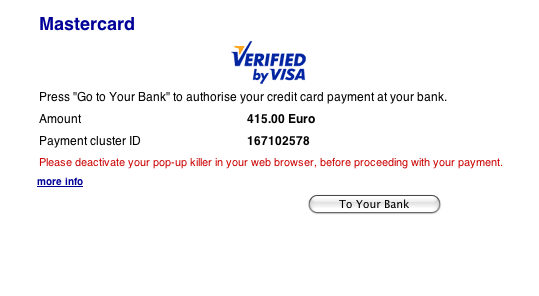
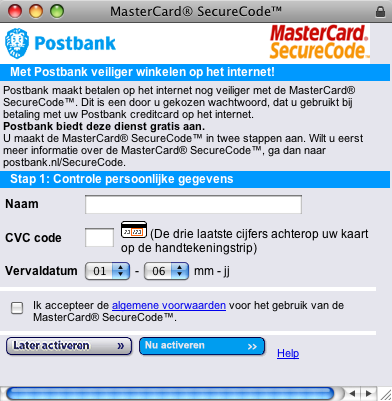
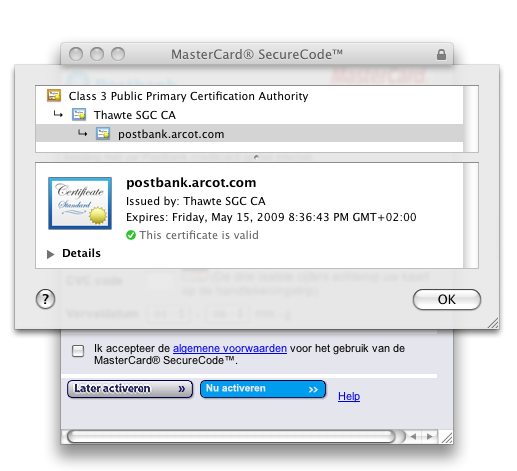
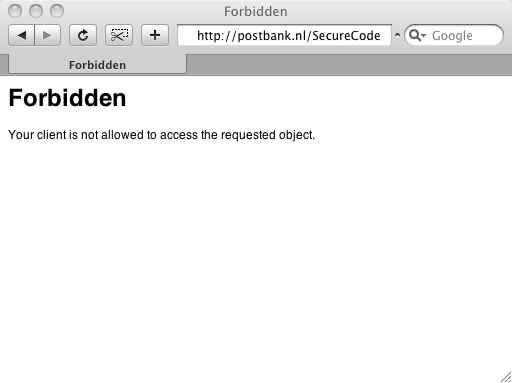
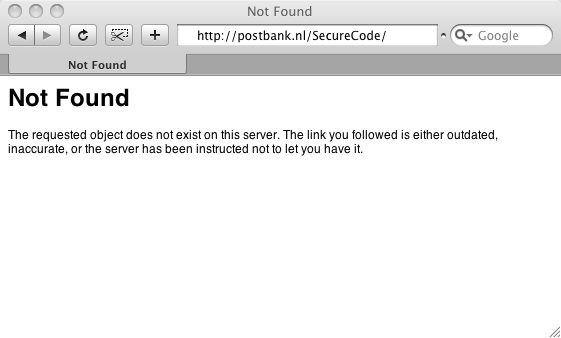
Leave a Reply